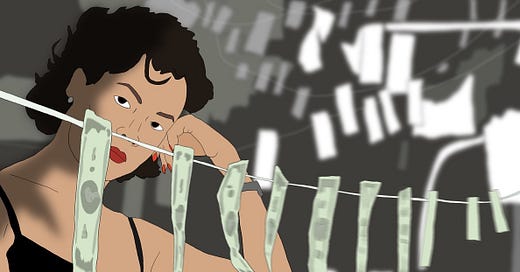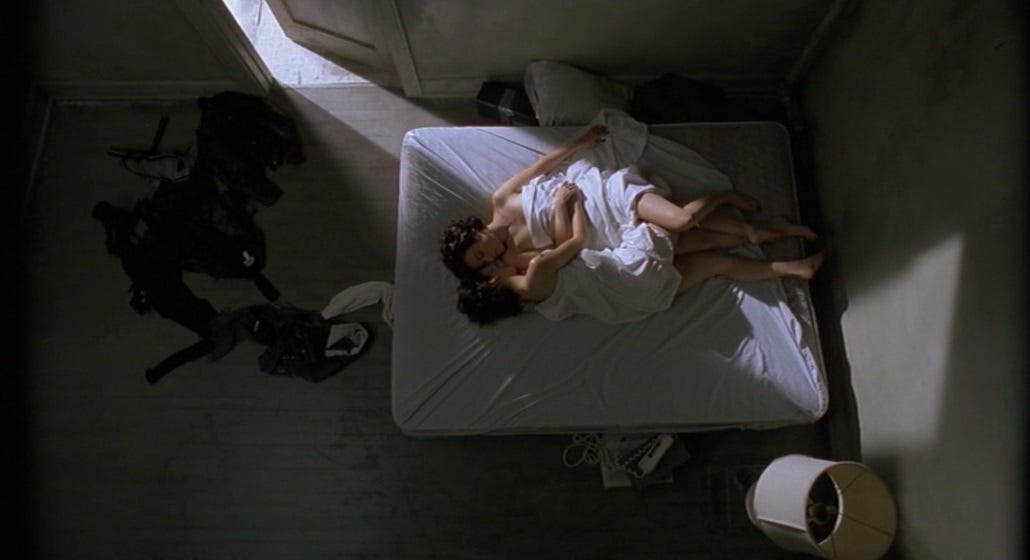From the Archives: You Can Believe What You Feel
The Wachowski sisters’ ‘Bound’ and the power of a femme (hold the fatale) + we’re 2!
The Yearning Rating: ✰✰✰✰½
Romance: ✰✰✰✰✰
Sex: ✰✰✰✰✰
Storytelling: ✰✰✰✰
Performance: ✰✰✰½
Yearning: ✰✰✰✰✰
The Yearning just celebrated its TWO YEAR ANNIVERSARY. We cannot express how thrilled we are to have this community to share with every week–whether you’re here because you love movies, reality TV, or just because you’re gay, we love you! Thank you for supporting our little obsession <3
An essay of appreciation with very little spoilers!
Written by Ali Romig
The film opens inside of a closet. A little on the nose, you might think. But this closet has little to do with what we’re trying to hide, and a whole lot more to do with the boxes in which the world tries to keep us confined. To this point, the overhead shot pans downward, revealing boxes within boxes. Shoe boxes, hat boxes…tidy, boxed shelving that hold all the tools of traditional femininity, including a seemingly endless supply of stilettos, until it finally finds its target. A butch woman, sporting tattoos, muddied Docs, and a ribbed tank, lays bound and gagged on the floor of the closet. She struggles as a string of voiceovers overlap—some sexual, some violent. Before the scene cuts to black, we hear one final, breathless plea: I want out.
The first scene of the Wachowski sisters’ directorial debut never fails to astonish me. The sheer amount of information it communicates in just sixty seconds is impressive on its own, but it's the tonal clarity it immediately establishes that really blows me away. As far as neo-noir goes, it’s a fairly average setup on paper—someone is locked inside a closet, probably about to get whacked. But who is this woman? She seems strong, tough, yet we find her in a moment of helpless vulnerability. And the delicate, feminine finery that fills the closet feels somehow sinister in this context. Is this woman our hero? Our villain? Or is that role for the other, husky-voiced woman introduced via voiceover? No one slots easily into the archetypes typically found in gangster films. In Bound, the Wachowskis seem to be saying, things aren’t going to fit neatly into boxes.
Bound plays with two classic film genres—noir and crime thriller—to tell the story of Violet (Jennifer Tilly), a mobster’s girlfriend, and Corky (Gina Gershon), an ex-con. The two meet in the elevator of the Chicago apartment building they’re both staying in—Corky is there as a hired plumber, and Violet lives there with her boyfriend, Caesar (Joe Pantoliano). The fact that their first encounter takes place in yet another confined space, made smaller by Caesar’s presence, doesn’t feel like a coincidence. Still, they manage to give each other the sapphic once-over behind Caesar’s back. Corky does so easily, and seems a little disarmed when Violent returns her obvious interest just as brazenly. It’s Violet who initiates their first real interaction when she brings Corky a cup of coffee while she’s working. From here the two fall into a clandestine affair, and eventually hatch a plan to steal millions from the mafia. What more could a couple of leather-clad dykes ask for?
The Wachowskis released Bound in 1996, three years before their major box-office success, The Matrix, and over a decade before either Lana or Lilly would eventually come out as transgender. Because neither was publicly out at the time of the film’s release, many critics and viewers neglected to seriously consider Bound “queer cinema”, despite centering a lesbian couple. Some well-intentioned critics naively lauded the film for featuring homosexuality without “being about homosexuality” while others opined that the directors simply used queerness to make an already controversial film more salacious. While the degree of ignorance varies in these takes, neither has aged well. It's odd to me, watching Bound now, that anyone could have ever seen it as anything but extremely and authentically queer. This is not an instance of genre film using queerness as a subplot, but rather a queer film using genre as the vehicle for an exploration of identity.
The conversations around queerness that take place in this movie are incredibly nuanced and for the most part, hold up. Violet and Corky’s love scenes are erotic and tasteful, passionate and delicate—they stand out as grounded and lived-in when compared to the comically hyperbolic violence featured elsewhere in the film. When Corky goes to a lesbian bar, all the patrons look like actual queer people you’d find in the wild, rather than a producer's idealized version of a movie lesbian. Gershon plays Corky as the game, resourceful butch, and does so successfully (how come Gershon never played butch again? I find her very hot like this!). Gershon also taps into the honesty of Corky’s character—as the lesbian ex-con, Corky doesn’t fit into this false world, and wears her refusal like a badge of honor. At first, it’s confusing to her why Violet’s taken a different route. Violet, in her little black dresses and heels. Violet, who has survived by making herself desirable to men with power. Violet who hides in plain sight.
For me, it’s Tilly’s portrayal of Violet that really highlights the innate queer sensibility of Bound. If we were to simply look at Violet and her femininity through the lens of the neo-noir crime thriller, we’d immediately see this characterization as limiting. We might expect one of two things from her—either to be the submissive arm candy, or the deceptive fatale. Violet manages to break out of either of these prescriptive roles. Instead, she’s not just feminine, she’s femme, and therefore unbound by traditional expectations or perceived restraints. Tilly and the Wachowskis’ understanding of this subtle difference is like a wink to queer viewers and a big “fuck you” to the historic misogyny of the genre.
The queer understanding of femme goes far beyond the aesthetic. It’s not just what you wear: it’s how you carry yourself, your intuition, and your ability to see possibilities where others see barriers. It’s an art. It’s also incredibly expansive. This is highlighted in one of my favorite scenes in the film. When Violet is seducing Corky, Corky has a hard time believing in Violet’s desire. “You can believe what you feel,” Violet says. She’s inviting Corky to look past the superficial cues we typically rely on to understand one another. The boxes we put each other in. To feel, taste, smell the whole of her. It’s an incredibly queer moment—both literally (they’re having gay sex) and symbolically. The Wacowskis understand that appearances are fragile and often false. In the morning, after Violet’s fucked Corky (again, expansive!), Corky says, “I can see again.” In surpassing the visual, true sight is renewed.
Ultimately, this is a movie about two different kinds of queer people who both see a wrongness in the world and work together to survive it. In the final scene, Corky asks Violet, “You know what the difference is between you and me?” Violet shakes her head. “Me neither,” Corky replies. It’s not that they’re literally the same. It’s that their differences are surface-level—just labels. Intangible. And you can believe what you feel.










